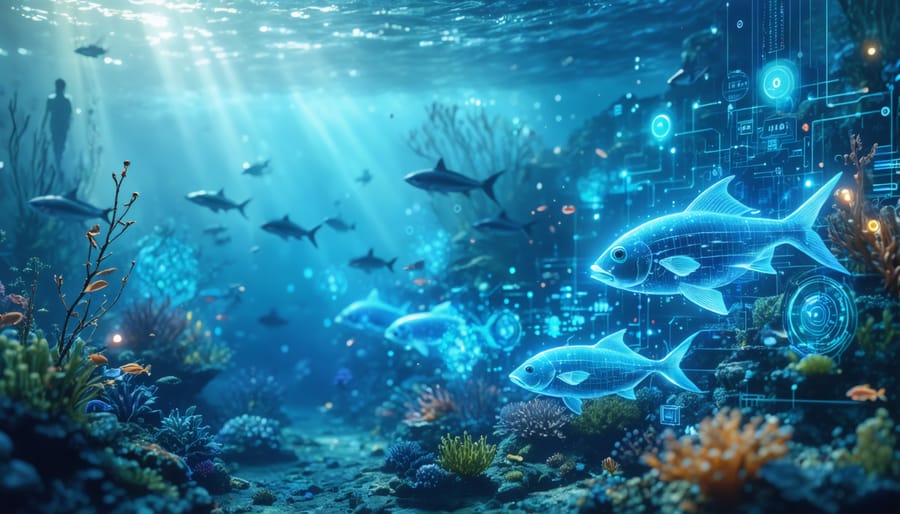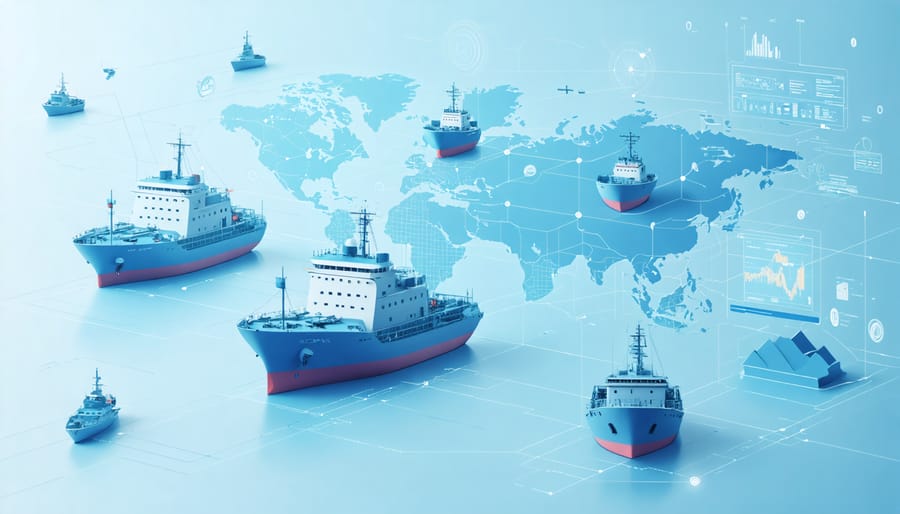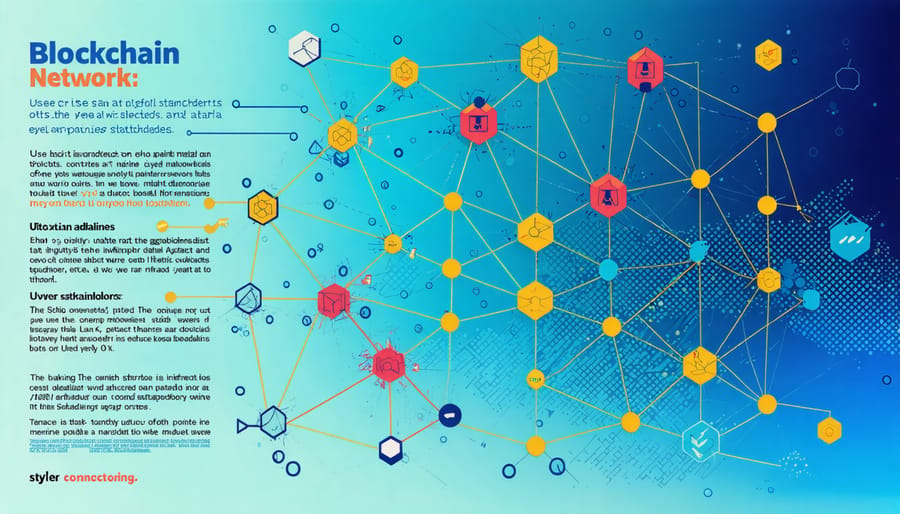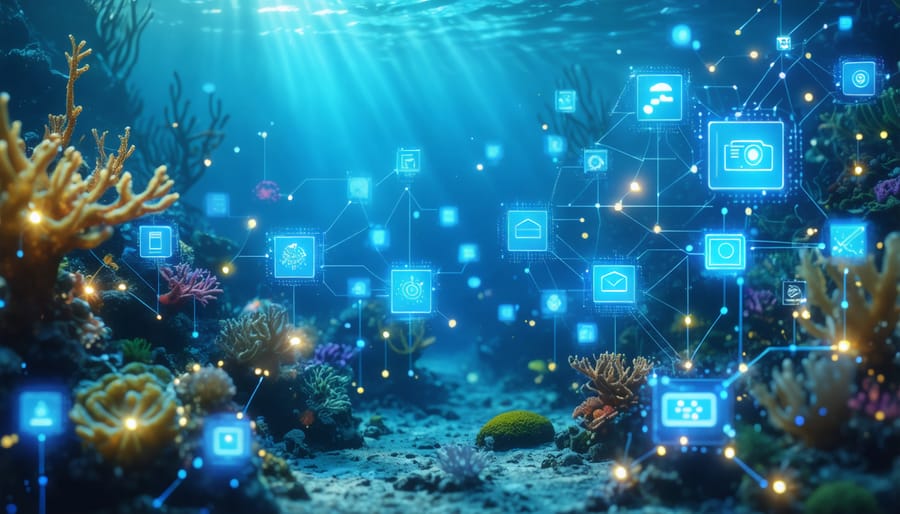
Emerging cybersecurity technologies are revolutionizing our approach to protecting marine ecosystems and their vital data systems. From autonomous threat detection to advanced encryption protocols, these innovations are reshaping how we safeguard our oceans’ most sensitive information and infrastructure.
Artificial Intelligence and machine learning algorithms now analyze vast datasets from marine sensors and satellite systems in real-time, identifying potential security breaches before they impact critical conservation efforts. Blockchain technology enables transparent and tamper-proof tracking of fishing activities and marine resource management, while advanced IoT security measures protect the growing network of ocean monitoring devices from cyber threats.
As environmental scientists and marine conservationists increasingly rely on digital tools for research and monitoring, these emerging security solutions provide a robust defense against evolving cyber threats. The integration of quantum encryption and biometric authentication systems ensures that sensitive marine biodiversity data remains secure while remaining accessible to authorized researchers and conservation teams worldwide.
This convergence of cybersecurity innovation and marine conservation demonstrates how technology can serve as a powerful ally in our mission to protect and preserve ocean ecosystems for future generations.
AI-Powered Marine Surveillance Systems
Machine Learning for Vessel Tracking
Machine learning algorithms are revolutionizing how we monitor and protect our oceans from illegal activities. These AI-powered systems analyze vast amounts of satellite data and vessel tracking information to identify suspicious patterns that might indicate illegal fishing or unauthorized maritime operations.
Advanced neural networks can now process Automatic Identification System (AIS) signals from vessels, detecting when ships attempt to hide their locations or engage in suspicious behavior. The algorithms learn from historical data to recognize patterns associated with illegal activities, such as sudden course changes, unusual speed variations, or frequent AIS signal gaps.
What makes these systems particularly effective is their ability to integrate multiple data sources. By combining AIS tracking with satellite imagery, weather data, and known fishing patterns, the AI can distinguish between legitimate fishing operations and potential violations. For example, when a vessel turns off its tracking system in known fishing grounds, the algorithm flags this as suspicious behavior for further investigation.
These technologies have already shown impressive results. In several pilot programs, machine learning systems have helped authorities identify and intercept illegal fishing vessels with greater accuracy than traditional monitoring methods. The technology has also proven valuable in detecting vessels entering protected marine areas or operating in restricted zones.
As these systems continue to evolve, they’re becoming more accurate and capable of processing information in real-time, allowing for immediate response to potential threats to marine ecosystems.

Automated Threat Detection
Artificial Intelligence is revolutionizing how we protect our marine ecosystems through advanced threat detection systems. These innovative AI solutions are becoming crucial tools in ocean policy enforcement and environmental monitoring, offering unprecedented capabilities in identifying and responding to threats in real-time.
Modern AI systems can analyze vast amounts of data from multiple sources, including satellite imagery, underwater sensors, and acoustic monitoring devices. These systems are trained to recognize patterns that might indicate illegal fishing activities, oil spills, or unauthorized vessel movements in protected marine areas. For instance, machine learning algorithms can detect unusual ship behavior patterns that might suggest illegal fishing operations, allowing authorities to respond more quickly and effectively.
The technology also excels in identifying environmental threats such as coral bleaching events, harmful algal blooms, and changes in marine mammal migration patterns. By processing data from underwater cameras and environmental sensors, AI systems can alert scientists to potential ecosystem disturbances before they become critical issues.
What makes these systems particularly valuable is their ability to learn and improve over time. As more data is collected and analyzed, the AI becomes more accurate in distinguishing between normal marine activity and potential threats, reducing false alarms while increasing the detection rate of genuine environmental concerns. This technological advancement has become an invaluable tool for marine conservationists and enforcement agencies working to protect our oceans.

Blockchain Technology in Ocean Governance
Secure Marine Data Management
In the era of increasing marine research and monitoring, protecting critical ocean data has become paramount. Blockchain technology is revolutionizing how we safeguard marine research data, offering an immutable and transparent system for tracking everything from water quality measurements to marine species populations.
Marine scientists and conservation teams are implementing blockchain solutions to create tamper-proof records of their findings. This distributed ledger technology ensures that crucial data about coral reef health, ocean acidification levels, and marine biodiversity remains intact and unaltered. When researchers collect samples or record observations, each data point is encrypted and stored across multiple nodes, making it virtually impossible for bad actors to manipulate the information.
The technology also enables better collaboration between research institutions while maintaining data integrity. For instance, when multiple teams study the same marine ecosystem, blockchain creates an auditable trail of who collected what data and when, preventing duplication and ensuring proper attribution of research findings.
Real-world applications include tracking illegal fishing activities, monitoring marine protected areas, and maintaining long-term datasets of ocean temperature changes. One notable success story comes from the Pacific, where blockchain-secured data helped identify and protect previously unknown coral reef systems by ensuring the geographical coordinates and survey data remained uncompromised.
For marine conservationists, this technological advancement means their years of research and monitoring efforts are now protected by one of the most secure systems available, allowing them to focus more on their vital work of ocean protection.
Smart Contracts for Ocean Resources
Smart contracts built on blockchain technology are revolutionizing how we manage and protect our ocean resources. These digital agreements automatically enforce conservation rules and resource management protocols, creating a transparent and tamper-proof system for marine protection. By integrating blockchain into ocean governance, we’re establishing a new framework for sustainable ocean development that benefits both marine ecosystems and coastal communities.
Marine biologist Dr. Sarah Chen explains, “Smart contracts allow us to automatically track fishing quotas, monitor protected areas, and ensure compliance with international marine treaties. When a vessel enters a protected zone or exceeds its catch limit, the smart contract triggers immediate notifications and enforcement actions.”
These contracts work by encoding conservation agreements into blockchain-based programs that execute automatically when specific conditions are met. For example, when fishing vessels report their catch through IoT sensors, smart contracts verify compliance with quotas and instantly flag violations. This system provides real-time oversight of marine resources while reducing the administrative burden on enforcement agencies.
Key benefits include:
– Transparent tracking of fishing rights and quotas
– Automated enforcement of marine protected areas
– Immutable record-keeping of resource extraction
– Improved coordination between international stakeholders
– Reduced illegal fishing through enhanced accountability
As these systems mature, they’re becoming powerful tools for protecting our oceans while ensuring fair access to marine resources.
IoT Networks for Ocean Monitoring
Smart Sensors and Data Collection
Modern sensor networks are revolutionizing how we monitor and protect marine ecosystems. These sophisticated systems combine underwater sensors, floating devices, and satellite technology to create a comprehensive picture of ocean health and marine biodiversity in real-time.
Advanced acoustic sensors can detect and identify marine species by their unique sounds, from the songs of humpback whales to the clicking of dolphins. Environmental DNA (eDNA) sensors analyze water samples to identify species present in an area by detecting traces of their genetic material, offering unprecedented insights into biodiversity without disturbing marine life.
Smart buoys equipped with multiple sensors measure crucial parameters like water temperature, salinity, pH levels, and dissolved oxygen. These measurements help scientists track ocean acidification, monitor coral reef health, and predict potential threats to marine ecosystems. Some advanced sensors can even detect pollutants and microplastics, enabling rapid response to environmental threats.
Data from these sensor networks is transmitted to cloud-based platforms where machine learning algorithms analyze patterns and trends. This information helps marine biologists and conservationists make informed decisions about protection measures and policy recommendations. The technology has already proven valuable in identifying illegal fishing activities and tracking the effects of climate change on marine populations.
Citizen scientists and volunteer groups are increasingly participating in data collection efforts by maintaining local sensor networks and reporting observations through mobile apps, creating a collaborative approach to marine conservation.

Securing IoT Infrastructure
In marine environments, securing IoT infrastructure presents unique challenges due to the harsh conditions and remote locations of ocean monitoring networks. These networks, comprising sensors, buoys, and underwater communication systems, require robust cybersecurity measures to protect valuable environmental data and ensure system integrity.
Multi-layered encryption protocols specifically designed for marine IoT devices help safeguard data transmission between underwater sensors and surface stations. These protocols account for the variable nature of ocean conditions and potential interference from marine activities. Advanced authentication systems verify the identity of devices and users accessing the network, preventing unauthorized access to sensitive environmental monitoring systems.
Physical security measures are equally crucial. Tamper-resistant housings protect underwater sensors from both environmental damage and potential security breaches. Regular maintenance protocols include security updates and firmware patches, delivered remotely when possible to minimize disruption to data collection.
Network segmentation plays a vital role in protecting ocean monitoring systems. By isolating critical sensors and creating separate networks for different types of data collection, security teams can contain potential breaches and maintain the integrity of essential environmental measurements. Real-time monitoring systems alert marine scientists to unusual patterns or potential security threats, allowing for swift response to protect both the infrastructure and the valuable ecological data it collects.
The implementation of these security measures requires collaboration between marine biologists, cybersecurity experts, and environmental agencies to ensure both effective protection and continued scientific value of the collected data.
Future Implications and Challenges
Emerging Technologies
In recent years, groundbreaking technologies have revolutionized our approach to marine protection and governance. Artificial Intelligence (AI) systems now analyze vast amounts of oceanographic data to detect illegal fishing activities and monitor marine species populations in real-time. These smart systems can identify vessels engaged in suspicious behavior and alert authorities immediately, significantly improving enforcement capabilities.
Blockchain technology has emerged as a powerful tool for ensuring transparency in marine industry sustainability practices and seafood traceability. By creating an immutable record of catch data, vessel movements, and supply chain transactions, blockchain helps combat illegal fishing and ensures sustainable resource management.
The Internet of Things (IoT) has enabled the deployment of advanced sensor networks throughout our oceans. Smart buoys and underwater drones collect data on water quality, temperature variations, and marine ecosystem health. These devices transmit information to central databases where machine learning algorithms identify patterns and predict potential environmental threats.
Satellite technology combined with advanced imaging systems provides unprecedented visibility of ocean activities. High-resolution imagery and radar systems can track vessels across vast distances, while sophisticated software analyzes this data to identify potential violations of marine protected areas.
These technological innovations are transforming our ability to protect marine ecosystems, but their success relies on continued collaboration between scientists, conservationists, and technology developers. As these tools evolve, they promise even more effective solutions for ocean conservation and governance.
Addressing Security Risks
As marine technologies become increasingly connected and data-driven, addressing security risks has become paramount for protecting our ocean monitoring systems. Organizations are implementing multi-layered security approaches that combine traditional cybersecurity measures with specialized solutions designed for marine environments.
Regular security audits and vulnerability assessments help identify potential weaknesses in marine monitoring systems before they can be exploited. This includes testing both hardware components, like underwater sensors and buoys, and software systems that process oceanographic data.
Encryption plays a crucial role in protecting sensitive marine research data during transmission from offshore installations to onshore facilities. Advanced encryption protocols ensure that data about endangered species locations, critical habitat information, and research findings remain secure from potential threats.
Access control systems have been enhanced to manage who can interact with marine monitoring equipment and data. Multi-factor authentication and role-based access control help prevent unauthorized access while ensuring researchers and conservation teams can efficiently carry out their work.
Organizations are also investing in staff training programs to build awareness about cybersecurity risks specific to marine technologies. This includes teaching best practices for secure data handling and recognizing potential security threats in the field.
Emergency response protocols have been developed to address security incidents quickly and minimize their impact on marine conservation efforts. These protocols include backup systems and redundancies to ensure continuous monitoring of marine ecosystems even during security events.
As we navigate the increasingly digital landscape of ocean governance, the role of cybersecurity technologies becomes ever more critical in safeguarding our marine ecosystems. The integration of AI, blockchain, and IoT devices has revolutionized how we monitor, protect, and manage our oceans, creating a more resilient framework for marine conservation efforts.
Looking ahead, the continued evolution of cybersecurity measures will be fundamental in addressing emerging challenges in ocean governance. As more nations and organizations adopt digital solutions for marine resource management, the need for robust security protocols becomes paramount. The success of conservation initiatives increasingly depends on our ability to protect sensitive environmental data, maintain the integrity of monitoring systems, and ensure transparent collaboration among stakeholders.
We’re witnessing a transformation where cybersecurity is no longer just about protecting data – it’s about preserving our ocean’s future. The technologies discussed throughout this article represent powerful tools in our conservation arsenal, but their effectiveness relies heavily on continued innovation in cybersecurity measures.
For marine conservationists and environmental scientists, staying informed about these technological advances is crucial. By embracing secure digital solutions while remaining vigilant about potential cyber threats, we can build a more protected and sustainable future for our oceans. The path forward requires ongoing collaboration between technology experts, marine scientists, and conservation practitioners to develop and implement even more sophisticated security measures that will safeguard our marine resources for generations to come.
jessica
Ava Singh is an environmental writer and marine sustainability advocate with a deep commitment to protecting the world's oceans and coastal communities. With a background in environmental policy and a passion for storytelling, Ava brings complex topics to life through clear, engaging content that educates and empowers readers. At the Marine Biodiversity & Sustainability Learning Center, Ava focuses on sharing impactful stories about community engagement, policy innovations, and conservation strategies. Her writing bridges the gap between science and the public, encouraging people to take part in preserving marine biodiversity. When she’s not writing, Ava collaborates with local initiatives to promote eco-conscious living and sustainable development, ensuring her work makes a difference both on the page and in the real world.
